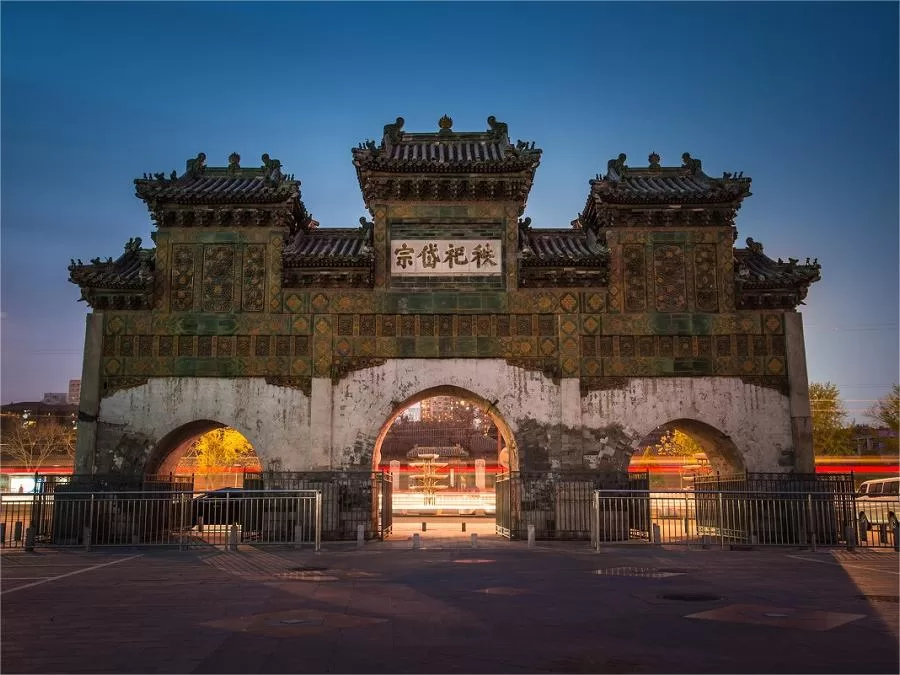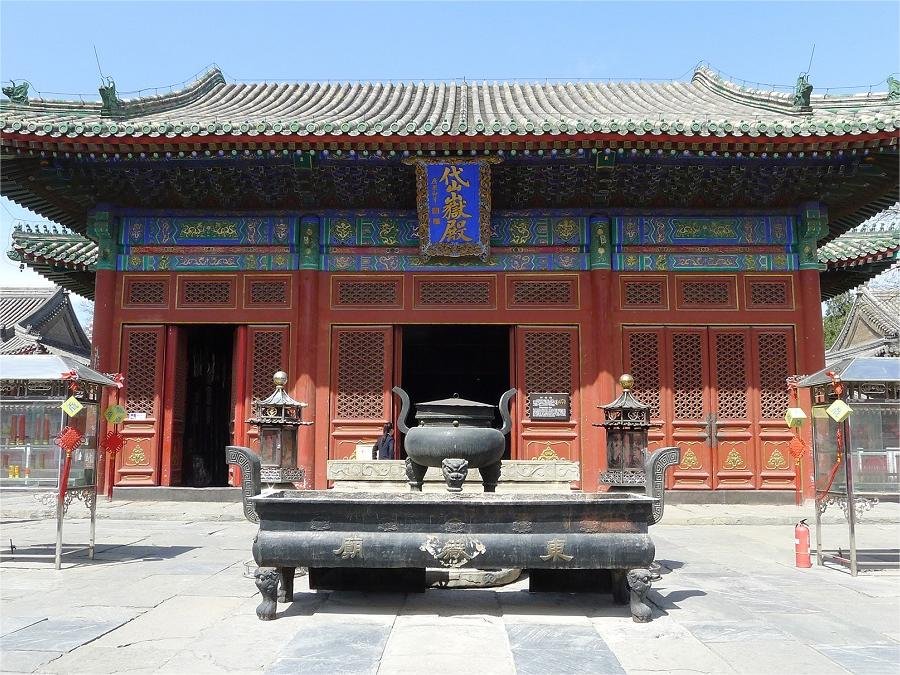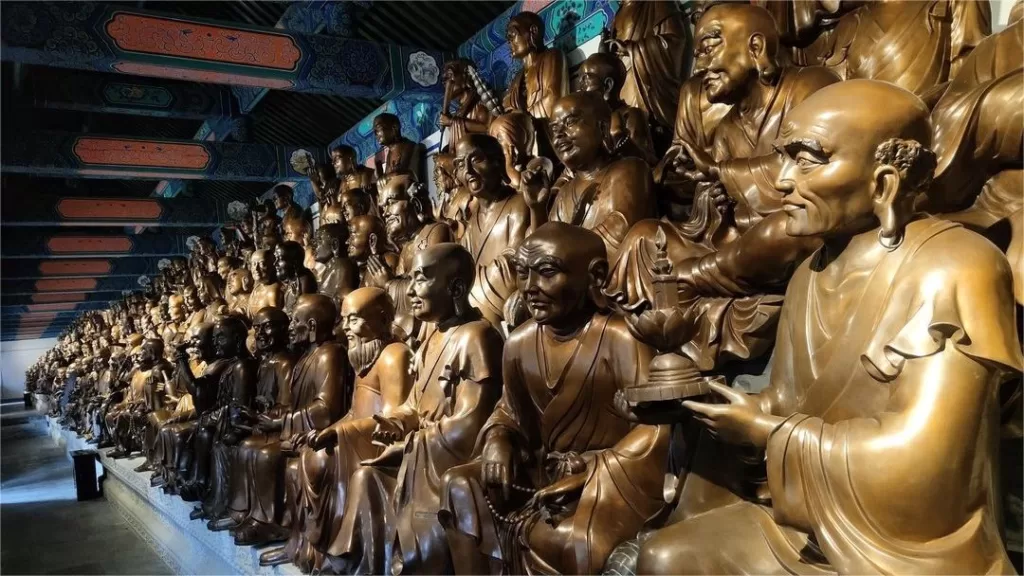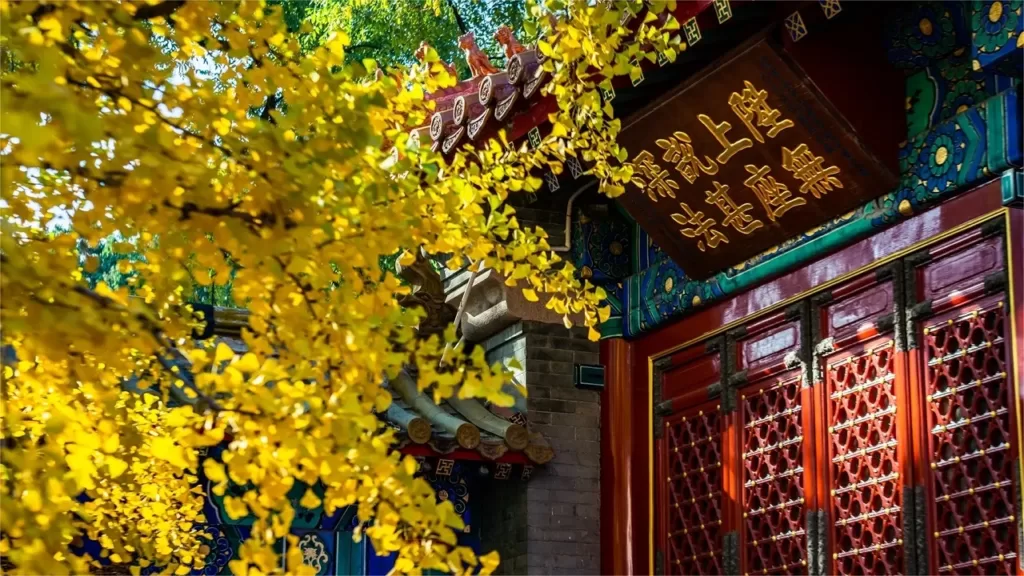Dongyue Taoist Temple (东岳庙), located in Beijing, is a historic and culturally significant religious site that holds a prominent place in Taoist tradition. With a history dating back over 600 years, the temple stands as a testament to the rich spiritual heritage of China.
Situated in the Chaoyang District, Dongyue Temple is renowned for its exquisite architecture and tranquil surroundings. Its design embodies traditional Chinese temple aesthetics, featuring magnificent gateways, ornate pavilions, and beautifully landscaped gardens. The temple complex covers a vast area, with various halls, courtyards, and altars dedicated to different deities and Taoist beliefs.
Dongyue Temple holds a special significance for Taoists as it is regarded as the headquarters of the Beijing Taoist Association. Devotees and visitors flock to the temple to pay homage to various Taoist gods, seek blessings, and participate in religious rituals and ceremonies. The temple’s serene atmosphere provides a sanctuary for spiritual reflection and meditation amidst the bustling city.
Table of Contents
- Basic Information
- Location and Transportation
- Who is Enshrined in the Temple
- Highlights of Dongyue Taoist Temple
- Vlog about Dongyue Taoist Temple
- History of Dongyue Taoist Temple
- Useful Tips Summarized from Reviews
- Other Temples in Beijing
Basic Information
| Estimated length of Tour | 1 – 2 hours |
| Ticket Price | 10 RMB |
| Opening Hours | 8.30 – 16.30 |
| Telephone Number | 0086-010-65510151 |
Location and Transportation
Dongyue Taoist Temple is situated in the Chaoyang District, which is a bustling area in Beijing. Its exact address is No. 141 Chaowai Street, Chaoyang District, Beijing, China. To get there, you can choose the following ways:
Bus: Take bus 75, 101, 109, 110, 139, or 615, get off at Shenlu Street Stop (神路街站), and you will be standing right at the entrance of the temple.
Subway: The nearest subway station to Dongyue Taoist Tempel is Dongdajie (东大街) on line 6. After getting out of the station from Exit A, walk about 600 meters to the west to reach the temple.
Who is Enshrined in the Temple
In Dongyue Taoist Temple, the main deity who is enshrined and worshiped is the Taoist deity Dongyue Dadi, also known as the Great Emperor Dongyue. Dongyue Dadi is considered the chief deity of the Mount Tai (Dongyue) pantheon, which is a group of heavenly officials and earth deities in Taoism.
Dongyue Dadi is believed to govern and oversee the affairs of the earth, including human affairs, blessings, and protection. As the patron deity of Dongyue Temple, he holds a central position in the temple’s religious ceremonies and rituals.
The worship of Dongyue Dadi emphasizes virtues such as righteousness, justice, and morality. Devotees seek his blessings for prosperity, success, and well-being in various aspects of life, including career, health, and relationships.
Highlights of Dongyue Taoist Temple
Architectural Splendor

The Dongyue Temple complex showcases grand gateways, intricately carved stone pillars, and exquisite halls adorned with colorful paintings and ornate woodwork. Its traditional Chinese temple design, influenced by the Ming and Qing dynasties, reflects the craftsmanship and attention to detail of the era. The temple’s beauty lies in the harmonious blend of architectural elements, creating a serene and visually stunning atmosphere. Dongyue Temple stands as a testament to the rich architectural heritage of China and captivates visitors with its timeless grandeur.
Sacred Altars and Halls

Dongyue Taoist Temple in Beijing houses a series of sacred altars and halls that captivate visitors with their spiritual significance. Each hall is dedicated to specific Taoist deities and spirits, featuring elaborate sculptures, statues, and vibrant paintings that depict Taoist mythology and pantheons. The atmosphere is imbued with reverence and devotion as devotees pay their respects and seek blessings from these revered figures. The intricate details and artistic representations within the altars and halls offer a glimpse into the rich Taoist traditions and beliefs, inviting visitors to immerse themselves in the spiritual heritage of China.
Yuelao Shrine

The Yuelao Shrine within Dongyue Taoist Temple is a dedicated space honoring the Taoist deity Yuelao, also known as the God of Marriage and Matchmaking. This shrine attracts visitors seeking blessings for love, relationships, and successful marriages. Adorned with offerings, prayer plaques, and red ribbons symbolizing love and connection, the Yuelao Shrine creates an atmosphere of romance and hope. Devotees come to seek Yuelao’s guidance and intervention in matters of the heart, believing in his ability to bring forth harmonious unions.
Dongyue Temple Fair

During traditional festivals such as the Spring Festival, Qingming Festival, Dragon Boat Festival, Mid-Autumn Festival, and Double Ninth Festival, Beijing’s Dongyue Temple hosts a variety of traditional folk activities. The Dongyue Temple Fair is one of the oldest temple fairs in Beijing’s history and a typical representation of Beijing’s temple fairs.
The Dongyue Temple Fair has its origins in the Yuan Dynasty, took shape during the Ming Dynasty, and reached its peak in the Qing Dynasty. Since the establishment of Dongyue Temple in the Yuan Dynasty, the fair gradually formed around it, involving participation from both the emperor and common people. It encompasses a wide range of activities, including folk beliefs, commercial trading, and entertainment, making it a significant event in the community’s cultural life.
Vlog about Dongyue Taoist Temple
History of Dongyue Taoist Temple
Yuan Dynasty (1276-1368)
The history of Dongyue Temple in Beijing dates back to the Yuan Dynasty. In 1276, Zhang Liusun, a Daoist priest from Jiangxi Province, traveled to the Yuan capital (present-day Beijing) to pay homage to Kublai Khan, the founder of the Yuan Dynasty. After being received by the Khan, Zhang decided to remain in the capital as a representative of the Daoist celestial master Zhang Zongyan.
In his later years, Zhang Liusun noticed that the capital lacked a proper temple dedicated to the God of Mount Tai, known as the Dongyue Emperor. Determined to fill this void, he initiated plans to construct a temple. In 1319, he acquired land outside the Qihua Gate (now Chaoyangmen) to build the temple. However, Zhang Liusun passed away before the project was completed.
In 1322, Zhang’s disciple, Wu Quanjie, continued his master’s mission. Wu oversaw the construction of the temple’s main hall and gate, completing them the following year. By 1323, Wu had added the eastern and western corridors and four subsidiary halls, sculpted statues of the deities, and obtained an imperial plaque inscribed with the name “Ren Sheng Gong,” signifying the temple’s official establishment.
In 1325, the Grand Princess of the State of Lu financed the construction of the temple’s rear hall, which was to serve as the divine abode. The following year, when the rear hall was completed, Emperor Wenzong of Yuan bestowed it with the name “Zhaode Hall,” marking another significant milestone in the temple’s history.
Ming Dynasty (1368-1644)
During the Ming Dynasty, Dongyue Temple underwent extensive renovations and expansions. In May 1447, Emperor Yingzong initiated repairs to the temple, which were completed by August. He personally authored an inscription for a stele to commemorate the event, renaming the front hall as “Daiyue Hall” and dedicating it to the God of Mount Tai. The rear hall was renamed “Yude Hall” and served as the abode of the Dongyue Emperor and his consort.
In 1560, an eunuch named Zhang Xian, grateful for his recovery from illness after praying at the temple, funded significant repairs. Under his direction, the temple’s halls, including the main hall, rear palace, and the eastern and western auxiliary halls, were restored, and new statues and ritual objects were added. To enhance the temple’s sanctity, Zhang Xian also built a screen wall to reduce external noise and drilled a well to provide water for pilgrims.
By 1569, benevolent individuals such as Lei Hong, Yu He, Wang Pan, and Wang Min, along with their supervisor Lei Qing, collectively donated funds to restore the statues of the Dongyue Emperor and the 76 subordinate deities. The restoration was completed in 1570, and a commemorative stele was erected.
In 1575, Empress Dowager Li, a devout follower of Daoism, donated her personal savings for further renovations. Leading by example, she encouraged Emperor Wanli, his brother Prince Lu, and other royal family members to contribute as well. Chief eunuch Feng Bao supervised the repairs, which concluded in 1576. Grand Secretary Zhang Juzheng composed an inscription to mark the occasion.
In 1585, Empress Dowager Li donated a large incense burner for the Daiyue Hall and replaced the incense burners in front of the 76 subordinate deities’ statues. Emperor Wanli even constructed a shrine dedicated to his mother at the southern foot of Mount Tai to honor the god perpetually.
By 1592, Emperor Wanli, believing he had received divine favor from the Dongyue Emperor in a dream, ordered extensive refurbishments. These included adding auxiliary halls to the left and right of the divine abode, constructing a rear building, and erecting two memorial arches at the temple gate, inscribed “Hongren Xifu” (Great Benevolence Brings Blessings) and “Lingyue Chongci” (Worship of the Sacred Mount).
In 1607, senior eunuchs Ma Qian, Chen Yongshou, and Lu Sheng funded the construction of a glazed archway in front of the temple, inscribed with “Zhisi Daizong” (Worshiping the Sovereign of Mount Tai) and “Yongyan Dizuo” (Extending the Imperial Line). By this time, the central part of Dongyue Temple had largely taken on its current layout.
Qing Dynasty (1644-1912)
During the Qing Dynasty, Dongyue Temple continued to be a significant religious site, undergoing several repairs and renovations. In 1651, the Binglinggong Hall was restored. In 1698, a fire caused by nearby residents severely damaged the temple. Emperor Kangxi ordered its reconstruction, which began in 1700 and was completed in 1702.
In 1761, another significant renovation took place under Emperor Qianlong, who, like Kangxi, personally wrote inscriptions for steles commemorating the event. These steles, inscribed in both Manchu and Chinese, were placed in pavilions to highlight the temple’s importance.
In 1836, the 17th Daoist priest of the temple, Ma Yilin, raised funds to build the Chunqiu Hall in the eastern corridor, connecting it to the central courtyard. He also restored the Doumu Hall, Huozu Hall, and built new halls dedicated to the Sea God and the God of Granaries. Additionally, he established a charity school within the temple to provide education for impoverished children, completing the temple’s basic structure as it is known today.
In 1900, during the Boxer Rebellion, the temple was used as a training ground by the Boxers.
Republic of China (1912-1949)
During the early years of the Republic of China, the temple suffered due to the chaotic warlord era. The presence of soldiers within the temple disrupted its operations, and the deteriorating political and social conditions led to a decline in its upkeep. The temple struggled to maintain itself and had to rely on renting out its property to cover daily expenses.
People’s Republic of China (1949-Present)
By the time the People’s Republic of China was established in 1949, Dongyue Temple was in a state of disrepair, with many of its statues damaged or destroyed. The temple was repurposed for use by various government agencies and schools.
In 1950, an explosion at a nearby gunpowder factory caused further damage to the temple, destroying some statues and the wooden memorial arches on either side of the temple, which were subsequently removed. The temple was then taken over by the Beijing Security Bureau, effectively closing it to the public.
From 1958 to 1962, during Beijing’s first cultural relics survey, the Beijing Cultural Relics Institute documented the temple’s ancient structures, steles, and artifacts. Detailed descriptions and rubbings of the steles were archived and stored in the National Library and the Capital Library.
In 1986, the Chaoyang District Committee and the Chaoyang District People’s Government formed a committee to oversee the restoration of Dongyue Temple. Recognizing the temple’s historical significance as the site of state ceremonies during the Ming and Qing dynasties and as the largest Daoist temple and fairground in northern China, the State Administration of Cultural Heritage and the Beijing Municipal Government decided to convert Dongyue Temple into the Beijing Folk Customs Museum after consulting scholars like Zhu Jiaqin, Luo Zhewen, Xie Chengsheng, and Zhong Jingwen.
In 1988, the temple’s Shanmen (mountain gate) was demolished during the widening of Chaoyangmen Outer Street. The second gate, Lingxing Gate, was then designated as the main gate.
In 1995, units stationed along the central axis of the temple began vacating the premises. By December of that year, the management and use rights of the temple were officially transferred to the Beijing Municipal Bureau of Cultural Relics, which in turn handed them over to the Chaoyang District Bureau of Culture and Cultural Relics. This marked the establishment of the Beijing Folk Customs Museum within Dongyue Temple.
Useful Tips Summarized from Reviews
Touching the Copper Mule: One of the highlights of the temple is the Copper Mule statue, believed to be the mount of Wen Chang, the God of Literature. Legend has it that touching the statue can heal illnesses and bring good fortune.
The Seventy-Six Departments: Upon entering the temple courtyard, you’ll notice two side corridors with seventy-six departments on each side. Each department is presided over by a deity responsible for judging good and evil. The statues in each department depict various scenes from the underworld. While observing these statues, it’s important not to offer prayers or worship.
The Stone Forest: Adjacent to the main hall, there are two stone forests, one on the east and one on the west. The east stone forest contains a significant monument called the “Daoxing Stele,” protected by a glass cover. This stele, written by the renowned calligrapher Zhao Mengfu, is a treasure of the temple. Although many stone monuments were destroyed during the Cultural Revolution, the remaining ones bear visible signs of damage and repair, offering insight into the temple’s tumultuous history.







